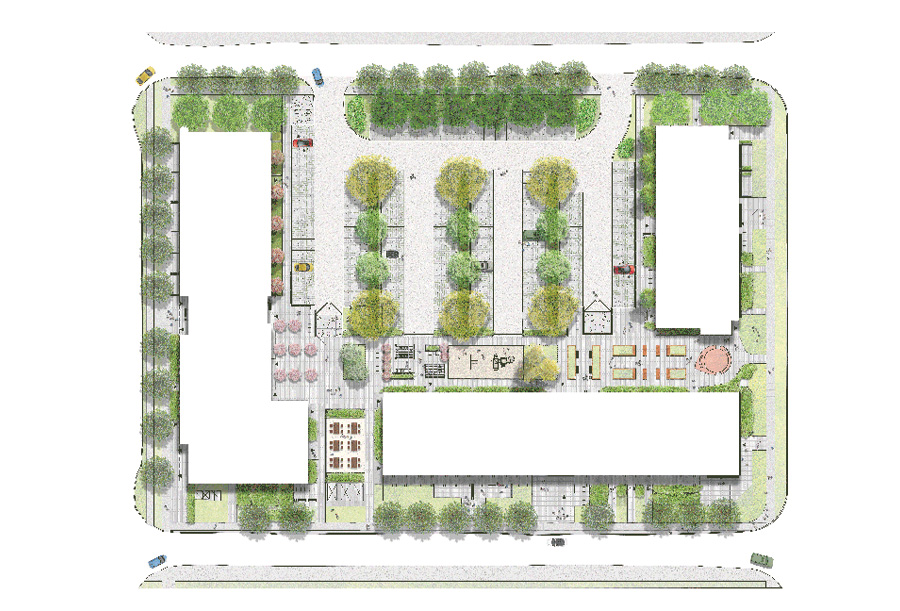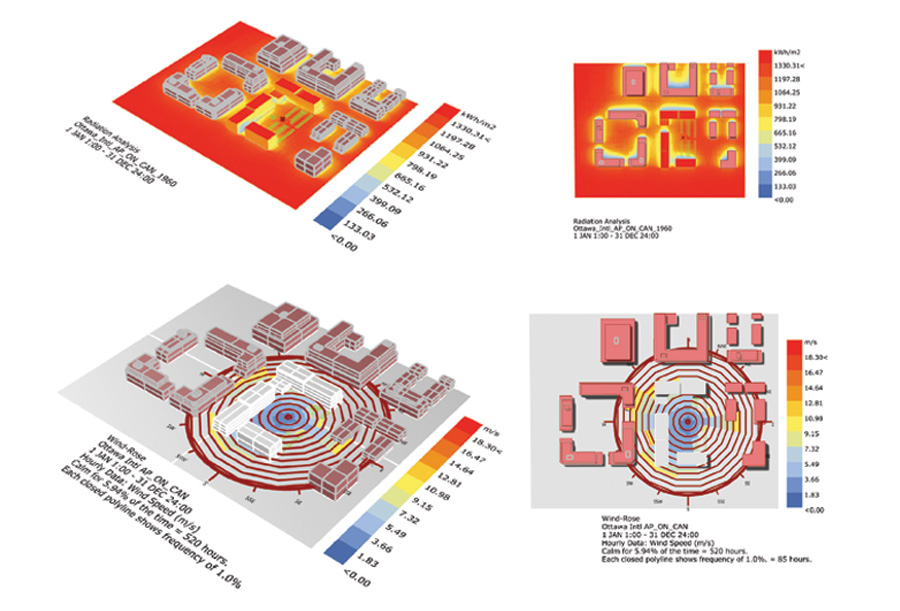Location: Ottawa, Ontario
Completed: 2024
Architect: Arcadis Architects (Canada) Inc.
Nominated by: Lucille Collard, MPP (Ottawa—Vanier)
With a gap in affordable housing and an opportunity for new urban development in Ottawa’s east end, Ottawa Community Housing (OCH) embarked on an ambitious plan to create a new community from scratch while adhering to leading sustainability standards.
An Opportunity to Address the Housing Gap
Located on the southern banks of the Ottawa River, Canadian Forces Base (CFB) Rockcliffe played a formative role in early Canadian aviation, hosting float planes and pilots as well-known as Charles Lindbergh. The base would operate continuously for decades, adapting to changing national defence needs until jet aircraft necessitated the move of air force operations to newer, longer runways. By 1994, the 130-hectare site was officially decommissioned, opening the opportunity for a new chapter on the site’s long history.
 Charles and Anne Linderbergh visit CFB. Image courtesy of Canada Department of National Defence/Library and Archives Canada
Charles and Anne Linderbergh visit CFB. Image courtesy of Canada Department of National Defence/Library and Archives Canada
Like many cities across Ontario, Ottawa faces a housing crisis, with a particularly acute gap in affordable homes. The vacant air base, located just 20 minutes east of downtown, represented a rare opportunity to both address a gap in the urban fabric and build new, affordable housing. In 2011, the Canada Lands Company purchased the site and plans began to take shape for a neighbourhood known as Wateridge Village.
Recognizing the site is located on the traditional, unceded territory of the Algonquin Anishinabee Nation, Canada Lands Company partnered with the Algonquins of Ontario (AOO) before any work began. They signed a participation agreement that ensures the AOO has engagement across all stages of development, land use planning, and design.
Mikinàk is one of three affordable housing projects at Wateridge Village. Designed as a triad of rectangular buildings partially enclosing a city block, the development provides 271 affordable homes as well as numerous inclusive outdoor and interior amenities for residents and the community.

Site plan of Mikinàk Ottawa Community Housing. Image courtesy of Arcadis Architects (Canada) Inc.
Deep Sustainability
Many certification programs and standards exist to provide architects and developers with a framework for achieving sustainability. Mikinàk embodies the requirements of numerous certification programs, including Passive House, WELL, and the Canada Green Building Council’s Leadership in Energy and Environmental Design (LEED) program and Zero Carbon Building standard. These programs seek to substantially reduce energy use, improve occupant wellbeing, and reduce resource use in the design and construction of a building.

Close up of Mikinàk Ottawa Community Housing's cladding. Image courtesy of Arcadis Architects (Canada) Inc.
Rigorous design and contract administration was crucial in meeting these stringent requirements. The use of parametric computer modeling enabled the design team to efficiently explore many design configurations, optimizing window size and placement to maximize solar heat gain in winter while minimizing the need for air conditioning in summer.
Careful detailing of the building’s envelope—which includes all elements that separate the interior from the exterior—allowed Mikinàk to achieve industry-leading energy use metrics. The anticipated annual energy demand for heating is less than 10 kilowatt hours per square metre per year (kWh/m2a), an order of magnitude better than typical residential construction in Canada. That’s about the same amount of energy used by a clock radio or electric toothbrush to heat each square metre of the building for a year.

Solar and wind analysis of Mikinàk Ottawa Community Housing. Image courtesy of Arcadis Architects (Canada) Inc.
Critical to achieving these sustainability goals was ensuring all of the details planned during design were followed through in construction. In this case, the architects assigned a certified Passive House Consultant (CPHC) Lead Contract Administrator to provide additional oversight on airtightness details, a critical component of the building envelope. This, paired with a construction manager who shared the same sustainability ambitions, has led to an exemplary building for sustainability and energy use.
As a result, the buildings at Mikinàk will use 57% less energy and produce 56% less CO2 or equivalents than required by the future 2025 National Energy Code of Canada for Buildings.
This post is part of the OAA’s Queen’s Park Picks 2024 series, where Ontario’s Members of Provincial Parliament (MPPs) were encouraged to nominate a building in their riding for a chance to learn more about it. This year, MPPs were asked to consider various typologies related to housing when making their suggestion, tying into the 2024 OAA Conference theme, Housing: Pushing the Envelope. Check out the rest of the series to learn more about great buildings across the province.